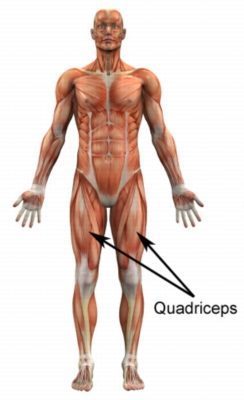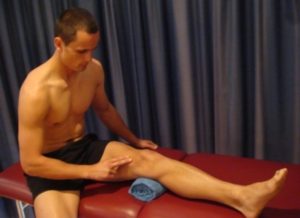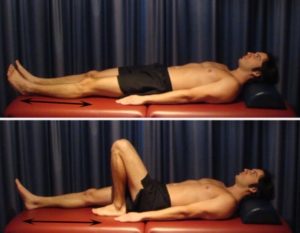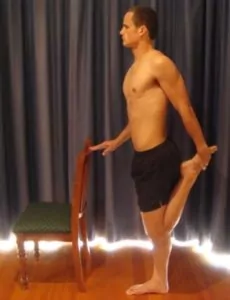Myositis Ossificans
Updated:
What is myositis ossificans?
Myositis ossificans is an uncommon condition that may occur following a thigh contusion (bruised thigh) and is characterized by bone formation (calcification) in the muscle belly at the site of the bruise.
The large muscle group at the front of your thigh is called the quadriceps (figure 1). The quadriceps is responsible for straightening the knee during activity and has a rich blood supply. Following a direct impact to the quadriceps, damage to the muscle fibres, connective tissue and small blood vessels of the quadriceps may occur. This results in a ‘bruise’ to the quadriceps and is known as a quadriceps contusion.

Quadriceps contusions can range from minor contusions resulting in minimal pain and allowing ongoing activity, to severe contusions resulting in significant pain and loss of function.
In severe cases, or in those cases that have been managed poorly, a small percentage of contusions may develop bony growths inside the bruised area of the muscle. This new bony growth takes place over a number of weeks, however, by approximately six or seven weeks, the bony growth ceases. At this stage a lump is often palpable. Slow resorption of the bone then occurs, over a period of weeks to months, but a small amount of bone may remain. This condition is known as myositis ossificans.
Causes of myositis ossificans
Myositis ossificans is a rare condition that may develop following a quadriceps contusion. Quadriceps contusions occur following a direct impact to the quadriceps muscle from an object or person. This most commonly occurs due to a collision with another player during contact sports such as football or rugby, or from an impact from a ball in sports such as hockey or cricket.
The exact reason as to why some of these contusions then go on to develop into myositis ossificans is not exactly known. However, there are a number of factors which may increase the likelihood. These include:
- Contusions that are severe
- Contusions resulting in a large loss of movement
- Contusions that are inappropriately managed
- Re-injury to the contusion (e.g. an additional impact)
- Patients who do not rest sufficiently following a contusion
- Patients who do not use ice following a contusion
- Patients who receive massage too soon or too vigorously following injury
- Patients who exercise (e.g. stretch) or perform activities into pain
- Patients who continue to play through injury
- Patients who recommence sport too early following injury
Signs and symptoms of myositis ossificans
Patients with this condition typically experience the usual symptoms of a quadriceps contusion in the initial stage of injury. These symptoms include pain during activities such as squatting, going up and down stairs, running, jumping, hopping, lunging or kicking. It is also common for patients to experience pain or stiffness after these activities with rest, especially upon waking in the morning. Swelling, tenderness and bruising may also be present in the quadriceps muscle, along with an inability to bend the knee as far as usual whilst keeping the hip straight. Patients may also be unable to walk without a limp. A visible increase in size of the quadriceps muscle may be detected due to bleeding and swelling. In these cases patients may be unable to sleep due to pain. Occasionally the swelling and bruising may track down to the knee joint or lower leg.
Within a few weeks following injury, further symptoms may then start to develop which suggest the presence of myositis ossificans. These symptoms include a noticeable lump or ‘woody’ feeling in the belly of the injured muscle, an increase in morning pain, pain with activity or night pain and a clinical history demonstrating an initial improvement in range of movement followed by a period of deterioration.
Diagnosis of myositis ossificans
A thorough subjective and objective examination from a physiotherapist can usually predict the likelihood of the presence of myositis ossificans. An X-ray approximately three weeks after the injury is usually required to confirm diagnosis. Further investigations such as an MRI scan or Ultrasound may be required, in some cases, to assist with diagnosis.
Treatment for myositis ossificans
The best strategy to manage this condition is to prevent its occurrence. Once myositis ossificans is established, there is very little that can be done to accelerate the resorptive process (i.e. the process of removing bone from the bruised region). Treatment will usually focus on rest from aggravating activities and the implementation of gentle pain-free range of movement exercises.
Diligently following the R.I.C.E. Regime in the initial phase of injury (first 72 hours) will greatly reduce the likelihood of a quadriceps contusion developing into myositis ossificans. This involves rest from aggravating activities, regular icing, the use of a compression bandage, and keeping the injured leg elevated above the level of your heart. The use of crutches when walking may be necessary to protect the quadriceps muscle from further damage and to hasten the healing process. Care should be taken not to exercise or stretch into pain as this may lead to further bleeding. The use of heat, massage and the consumption of alcohol in the initial stages (for at least the first 72 hours) should also be avoided.
When myositis ossificans has been confirmed on X-ray and when symptoms are persisting, a review with an orthopaedic specialist may be indicated to discuss management options. In some instances surgery may be considered to remove the bone although anecdotal reports suggest that surgery may not be beneficial and occasionally may accelerate the progress of the condition.
Exercises for myositis ossificans
The following exercises are commonly prescribed to patients with myositis ossificans. You should discuss the suitability of these exercises with your physiotherapist prior to beginning them. Generally, they should be performed 3 times daily after the initial 72 hour period and only provided they do not cause or increase symptoms.
Static Inner Quadriceps Contraction
Tighten the muscle at the front of your thigh (quadriceps) by pushing your knee down into a towel. Put your fingers on your inner quadriceps to feel the muscle tighten during contraction (figure 2). Hold for 5 seconds and repeat 10 times as hard as possible pain free.

Knee Bend to Straighten
Lying on your back, slowly bend and straighten your knee as far as possible without increasing your pain (figure 3). Repeat 10 – 20 times.

Quadriceps Stretch
Use a chair or table for balance. Take your heel towards your bottom, keeping your knees together and your back straight until you feel a gentle stretch in the front of your thigh or as far as you can go without pain (figure 4). Hold for 15 seconds, 4 times at a mild to moderate stretch pain-free.

Physiotherapy products for myositis ossificans
Some of the most commonly recommended products by physiotherapists to hasten healing and speed recovery in patients with myositis ossificans include:
To purchase physiotherapy products for myositis ossificans click on one of the above links or visit the PhysioAdvisor Shop.
Find a Physio
Find a physiotherapist in your local area who can treat myositis ossificans.

Link to this Page
If you would like to link to this article on your website, simply copy the code below and add it to your page:
<a href="https://physioadvisor.com.au/injuries/thigh/myositis-ossificans”>Myositis Ossificans – PhysioAdvisor.com</a><br/>PhysioAdvisor offers detailed physiotherapy information on myositis ossificans including: causes, symptoms, diagnosis, treatment, exercises, physiotherapy products and more...
Return to the top of Myositis Ossificans.

